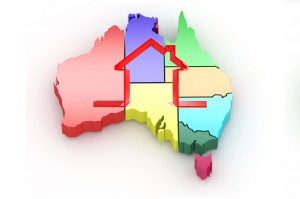It’s time for a whip around the country to see how our property markets are performing and to look at the factors affecting their future.
CoreLogic recently released their chart pack for February which gives us a good overview of what’s happening as well as some of the economic factors impacting our markets.
HERE’S SOME KEY POINTS FROM THEIR REPORT AND MY THOUGHTS
Dwelling values increased by 0.7% in January taking values 10.7% higher over the past year
- Across the individual capital cities, the annual change in home values have been recorded at +16.0% in Sydney, +11.8% in Melbourne, +4.4% in Brisbane, +4.8% in Adelaide, -3.2% in Perth, +7.8% in Hobart, -0.7% in Darwin and +6.7% in Canberra
- House values across the combined capital cities increased by 11.1% over the year compared to an 8.0% increase in unit values.
- Combined capital city dwelling values increased by 0.7% in January 2017 with values higher across all capital cities except for Darwin
- Home values were 2.3% higher over the three months to January 2017 with values rising across all capital cities over the period
What the chart above doesn’t really show is how fragmented our property markets are.
While combined capital city index, which is heavily weighted towards the Sydney property market and Melbourne property market, recorded a 10.7% rise over the last year, as you can see in the following graphic capital city growth varies greatly, with the Sydney property market once again the strongest market growing at 16% over the last 12 months.
Settled home sales had stabilised prior to their seasonal slowdown in December and January
- Over the 12 months to January 2017 it is estimated that there were 329,316 houses and 133,232 units sold and settled nationally with house sales -7.6% lower and unit sales -13.4% lower over the year
- Across the combined capital cities there were an estimated 197,280 houses and 96,590 units sold over the 12 months to January 2017. House sales are -10.7% lower over the year while unit sales are down -15.3%
- It is important to note, the large volume of off-the-plan sales currently means there is a high likelihood unit sales volumes will be revised higher over the coming years, these properties will be entered into the database at their contract date but will not be available until they have settled.
THERE ARE SOME STRONG SIGNALS FOR OUR MARKETS:
The average length of time a home sits on the market and the level of discounting is trending lower
- The typical capital city house is currently selling after 38 days compared to 41 days a year ago while the typical capital city unit takes 41 days to sell compared to 43 days a year ago
- The average level of discount across the capital cities is recorded at 5.6% for houses and 5.7% for units compared to 6.3% for houses and 6.0% for units 12 months ago.
Although advertised listings are always low through January, they are substantially lower than a year ago currently
- Over the past 28 days there were 33,899 new homes listed for sale nationally and 20,083 of these were listed across the capital cities
- New advertised properties for sale are -25.2% lower than they were a year ago nationally and -20.2% lower across the combined capital cities
- There were 215,119 total properties advertised for sale nationally over the past four weeks and 91,634 across the capital cities
- Nationally, total stock for sale is -11.6% lower than a year ago while they are -8.5% lower across the combined capital cities.
DESPITE APRA’S BEST EFFORTS, INVESTORS ARE STILL VERY ACTIVE IN OUR MARKETS…
The strong levels of investor lending have again caused some of the banks to further restrict lending to property investors over the last few weeks.
Source of all charts: Corelogic.com.au
WHAT’S HAPPENING AROUND THE STATES?
I remember 12 months ago, at the beginning of 2016, many were prepared to write off the Sydney property market saying that not only was the boom over, but Sydney property values were going to crash.
But Sydney’s fundamentals were strong and after a slight lull at the beginning of last year, Sydney’s price growth over 2016 was stronger than any other capital city finishing up 16% over the last 12 months.
The Melbourne property market also performed well over the last year, with strong population growth (over to 2% per annum) and a relatively strong economy creating more jobs underpinning its growth.
Brisbane’s property market has confounded those “hot spotters” who have predicting it was going to be “the place to be” for the last few years.
While overall growth in Brisbane was +4.4%, the market is very fragmented and there are still some areas that are performing respectably and have good investment prospects.
On the other hand, there is a significant oversupply of new high rise off the plan apartments overshadowing the inner city area and nearby suburbs.

The Perth property market is still in its slump phase with a significant oversupply of properties for sale and even though values rose a little at the end of the year, overall home values finished the year lower than they started.
I believe there is still some downside to the Perth market as it works its way through the excesses of the mining boom.
Hobart property performed well last year, and even though some commentators are suggesting it’s a good place to invest “because it has to catch up”, with minimal population growth and slow economic growth there seems little reason for property values in Hobart to grow substantially. They have only increased by 10.6% in the last 8 years.
Darwin property values were flat for most of 2016, but even after a little flurry in the last quarter, overall prices fell -0.7% over the last year.
Canberra’s property market performed strongly last year and is the only housing market, other than our 2 big capital cities, where the cumulative capital gain has been greater than 20% post GFC.
ECONOMIC DATA REMAINS MIXED
The rate of population growth at a national level is lower than recent highs but has steadied over recent quarters thanks to improving net overseas migration.
Victoria is seeing a substantially more rapid rate of population growth than all other states and territories
Dwelling approvals increased in November following a substantial decline in October however, approvals remain well below recent peaks due to a substantial recent fall-away in unit approvals
Consumer sentiment remains at a fairly neutral setting although it was more pessimistic than optimistic in the last few months.
As you can see from the graphs below, the number of properties for sale as well as dwelling values are closely linked to consumer sentiment.
Although the unemployment rate has been trending lower, the economy has shed full-time jobs over the past year with all new jobs created being part-time.
The Reserve Bank left official interest rates on hold at 1.5% in December 2016 and there is no meeting in January however, many lenders have begun lifting rates independently on some mortgage products over recent months.
Economic data shows mortgage demand to investors continues to climb at the same time as new dwelling approvals are trending much lower.
The value of new mortgage lending continued to rise in November 2016 however, the growth is being driven by an ongoing lift in investor mortgage commitments while owner occupier demand has stalled over recent months
On a similar note, housing credit growth has slowed with owner occupier credit growth slowing and investor credit demand expanding although, it remains well below APRA’s 10% pa threshold having increased by 6.2% over the past year
Source of all charts: Corelogic.com.au
The bottom line… 
Despite our low interest rate environment, Australia’s property markets are very fragmented and driven by local factors including jobs growth, population growth, consumer confidence and supply and demand.
The Melbourne and Sydney property markets are likely to once again outperform the other states in 2017 as continuing demand from investors and wealthy home owners once again drives capital growth.
However, the looming oversupply of new and off-the-plan apartments in Brisbane, Melbourne, and to a lesser extent Perth is likely to put a damper on inner-city property values, and as always, the level of property price growth will depend on what the Reserve Bank and the banks do with interest rates.
WHAT CAN YOU DO TO STAY AHEAD?
If you’re looking for independent advice, no one can help you quite like the independent property investment strategists at Metropole.
Remember the multi award winning team of property investment strategists at Metropole have no properties to sell, so their advice is unbiased.
Whether you are a beginner or a seasoned property investor, we would love to help you formulate an investment strategy or do a review of your existing portfolio, and help you take your property investment to the next level.
Please click here to organise a time for a chat. Or call us on 1300 20 30 30.
When you attend our offices in Melbourne, Sydney or Brisbane you will receive a free copy of my latest 2 x DVD program Building Wealth through Property Investment in the new Economy valued at $49.
from Property UpdateProperty Update http://propertyupdate.com.au/housing-market-economic-update-chart-pack-february-2017/






























No comments:
Post a Comment